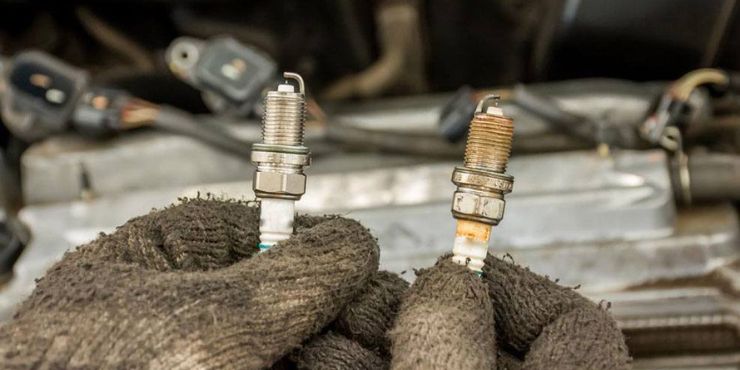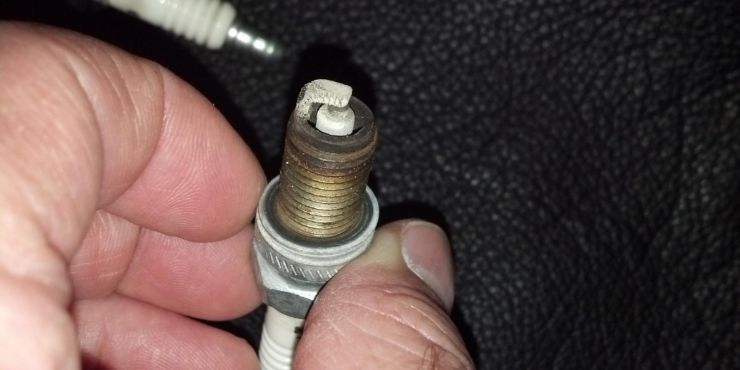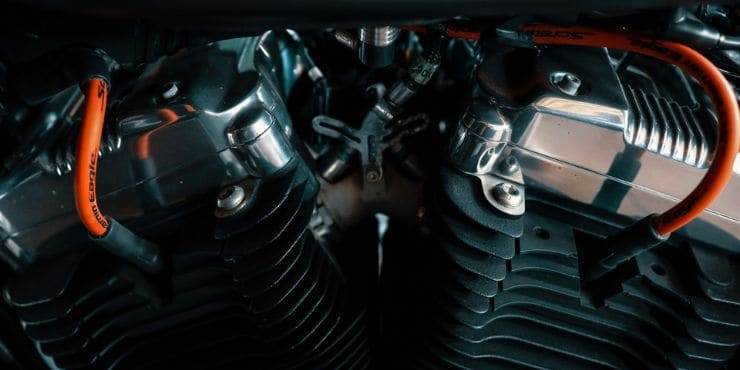Do you own a Harley-Davidson bike, and you’re curious to find out how many spark plugs it has? If yes, then you’re definitely in the right place.
Most Harley-Davidson motorcycles have two spark plugs, one for each cylinder in the V-twin engine.
In this article, you’ll get to know all about Harley-Davidson spark plugs, how many spark plugs does a Harley have, important things to know about spark plugs, how to change the spark plugs in your Harley-Davidson bike, and more. Stick around to know all the answers that you’re looking for.
How many spark plugs does a Harley have
Whether in bikes, cars, or lawnmowers, engines usually exhibit telltale signs that they aren’t working efficiently. For instance, the texture and color of the engine’s oil, for instance, reveal a lot to trained mechanics. They can quickly tell how dirty or old the oil is just by looking at it. The same will be true of your Harley-Davidson bike’s spark plugs.
In a Harley-Davidson motorcycle, there are between one and six spark plugs, and the number depends on the engine type. Spark plugs are the catalyst for your bike’s engine. These components create a spark in the combustion chamber of the engine, which ends up igniting the fuel. Observing your motorcycle’s spark plugs will allow you to determine the efficiency and condition of the engine. Similar to detectives examining the clues to a crime, you’ll be able to obtain valuable information by looking at the spark plugs. This info includes whether your engine is running right, getting enough fuel, getting too much fuel, or more.
When checking your bike’s plugs, you should first check the color by checking out the porcelain insulator below the electrode. Here are what the different colors of spark plugs signify –
Tan color
Tan-colored plugs mean that the engine is running normally while the air/fuel mixture is correct. You won’t have to replace the plug at the moment.
Black, dry, and fluffy color
Black, dry, and fully colored plugs indicate that the engine is excessively idle or running too rich. Black smoke coming out of the exhaust is another indication of a rich air/fuel mixture. You’ll have to find the cause of the rich air/fuel mixture before you install a new spark plug. The causes include a dirty air filter, a choke that might require sticking, or a carburetor screw that requires adjusting.
Black, wet, and glazed color
Black, wet, and glazed plugs indicate that the burned oil has been leaking past the valve guides or piston rings and burning in the cylinder. It can even mean that there’s wear and tear in the engine and that it needs rebuilding. You shouldn’t be surprised if you notice blue smoke coming from the exhaust.
White plugs
White-colored plugs indicate that the engine is overheating, which can be due to many factors. Some common ones include the octave in the gas being too low, the engine’s heat range being too hot, the carburetor running too lean, or the ignition timing not being set correctly. Failure to repair the engine could result in severe damage down the road, in case it hasn’t occurred already.
As you can see, once you’re aware of what you’re looking for, spark plugs can reveal a lot. A general rule of thumb would be to check your motorcycle’s spark plugs a couple of times a year. Moreover, you should also check the spark plugs before every long road trip. They’re critical engine components, but they’re inexpensive and easily replaced. So, it isn’t foolish to not check them. When it comes time to replace them, be sure that you’re using new plugs that have a similar heat range as your old ones. New plugs will add more power to the engine, as their squared edges will help the plug fire better. New, well-conducted spark plugs will make a great-running Harley-Davidson engine run even better. These components will mean improved gas mileage, more power, and overall better engine efficiency.
Important things to know about spark plugs
One of the parts of a bike that’s taken for granted the most is the spark plug. The dramatic improvement in other departments like ignition systems, fuel delivery systems, fuels, and the plugs themselves over the past few decades could be a reason for that.
The motorcycle components have gotten so reliable that they don’t demand much attention. However, it’s still a great idea to know a couple of things about spark plugs and maintain them properly.

In the 70s, whether you drove a bike with a two-stroke or four-stroke engine, spark plugs introduced themselves into your life more often than today. They did so by either fouling out or by having short service lives. Back then, if you rode a bike with a two-stroke engine, you couldn’t go anywhere without at least a spare plug.
These days, spark plugs tremendously benefit from the power of high-energy electronic ignition systems, higher quality and cleaner-burning fuels, the precision of electronic fuel injection, and improved materials like copper, platinum, and iridium. The fundamentals are still the same. The spark plug should deliver the right amount of energy for igniting the fuel at the right time. However, there’s a lot more to spark plugs as Kevin Cameron talks about it in his book Sportbike Performance Handbook. So without further ado, let’s find out the important things to know about spark plugs.
1. The science behind how ignition happens
It isn’t only about making some high voltage electricity jump a gap. It’s also about the electrons violently slamming into atoms liberating more electrons in instantaneous chain reactions of gap ionization, chemical destruction, and reconstruction as combustion. Each cycle of fuel that gets drawn into the cylinder and compresses and ignites an engine turning 10,000 RPM takes 1/100th of a second.
2. The significance of the gap
A spark plug has two components that create the gap – the ground electrode and the center wire. Generally, the center wire will have a negative charge while the ground electrode will have a positive one. The bigger the gap, the larger will be the amount of fuel-air mixture that gets subjected to gap ionization. If the gap isn’t correct or if it’s too wide or too narrow, it could cause misfiring, power loss, poor fuel economy, or engine damage over time.
3. All spark plugs aren’t alike
There are different types of plug gap configurations that exist. With the standard plug gap, the center wire tip is almost even with the edge of the threads. Meanwhile, the ground electrode protrudes beyond the level of the threads.
A projected tip plug features the insulator around the center wire, with the wire itself protecting beyond the level of the threads. Meanwhile, the ground electrode is correspondingly further out. Projecting the tip to the combustion chamber will allow for a more uniform flame spread on ignition.
A fine wire plug makes use of a smaller diameter center wire compared to a standard plug. A retracted gap plug features the electrode set and center wire inside the threaded portion of the plug. Here, the ground electrode is attached to the inside of the threaded portion. The surface gap plug doesn’t use the standard center wire and ground electrode configuration. The difference between the plugs is a lot more than cosmetic, as their performance characteristics are different. They’re designed for a specific engine, fuel, and ignition system types.
For this reason, experimenting with changing out spark plugs shouldn’t be done willy-nilly. Only using the spark plug types mentioned by your bike’s manufacturer will be the best way of optimizing performance, preventing potential engine issues, and protecting the warranty.
4. Spark plugs come in various heat ranges
Staying within the designated heat range for your engine will be crucial. With that said, a motorcycle’s manufacturer might specify spark plug heat range options for different operating or environmental conditions. Be sure that you’re checking the owner’s manual or talking to the dealer before changing to a heat range that is something other than what was specified.
While it’s true that performance can be improved by changing the spark plugs, do it within the manufacturers’ specifications. If you’ve got engine modifications, consulting an expert in performance modifications will be a great idea. It’ll help you greatly if you’re looking to maximize engine output without minimizing the engine life.
A visual way of estimating heat range will be by the length and girth of the insulator around the center wire. Generally, a longer, slender insulator will indicate a hotter heat range plug. Meanwhile, a thicker or shorter insulator construction will indicate a colder heat range. Manufacturers might offer more detailed info on the heat ranges of their products. Meanwhile, there are brand cross-reference charts that can be used to select spark plugs. Heat ranges are generally expressed in numerical terms, with lower values (2-6) being hotter and higher values (7-11) being the colder plugs.
5. Exotic center wire materials, configurations, and designs are readily available
It depends on many factors whether the spark plugs deliver higher performances and longer services than a fresh set of standard spark plugs.
One of the factors that might affect your decision to give these types of plugs a try will be the cost. While spark plugs are often affordable, some types of spark plugs can be extremely pricey. Asking your Harley-Davidson dealer can provide you helpful information on which type of plug will work best for your bike. Sometimes, even spark plugs specified by the manufacturer can have noticeable differences in service life.
For instance, sometimes, platinum plugs could outlast the standard plug by a wide margin. Meanwhile, there are also precious metal materials available that might be worth checking out. Resistor plugs are extremely useful in certain applications too.
Diagnosing engine anomalies can be done by having a look at the spark plugs. The widely accepted normal condition for a used spark plug in a proper engine is a gray or light ash color on the ground electrode, center wire, and the plug’s ends. Black carbon build-up indicates too rich a fixture or having low voltage in the ignition.
An eroded center wire or ground electrode or excessively wide gap could indicate a worn-out plug. Wet/oily plug surfaces can indicate severe engine wear at the oil control ring on the piston and valve guides. Evidence of melting of the center wire or ground electrode indicates pre-ignition because of incorrect heat range or other issues.
When changing or regapping/cleaning the spark plugs, remember that you should check the plug connection caps and wires. They could have cracks or other issues like wear or damage that can lead to performance or current loss. Installing new plugs on worn-out connector caps or wires is unlikely to resolve the issue. Moreover, check, clean, replace, or re-gap the spark plugs at service intervals recommended by your motorcycle manufacturer.
How to replace spark plugs in a Harley-Davidson bike?
Here, you’ll get to know how you can easily remove your old spark plugs, check the new ones for installation, prepare them, and install the new spark plugs. But before beginning with the steps, there are certain tools that you’ll be using – torque wrench, spark plug socket, spark plug gap gauge.
1. Locate the spark plugs
The spark plugs are easy to spot, and they’re located on the left side of your motorcycle. The process to remove the spark plugs will be the same for the front and back cylinders. Moreover, either spark plug can be replaced first.
2. Remove the old spark plugs
Slowly and carefully, remove the spark plug wire. Remember that you shouldn’t pull on, just pull the wire, squeeze the plug boot and then pull it together with the wire.
Take an 11/16” spark plug socket and unscrew the spark plug by turning it in a counterclockwise direction. There are some aftermarket spark plugs that might use a slightly larger 18mm spark plug socket. Carefully, remove the plug from the cylinder.

3. Check the new spark plug
It would help if you always inspected the new spark plug before you install it. Check the gap on the replacement spark plugs using a feeler gauge. It needs to be set to 0.40 inches or 1.016 mm. If they’re not pre-installed, ensure that the crush washer and terminal nut have been installed.
4. Install the new spark plug
Using your hands, install the new spark plug into the socket and then hand tighten it until firm. Use a torque wrench to tighten the spark plug to the proper specification. When you’re installing spark plugs, proper torque is essential. If they’re too loose, they might rattle out or leak. Meanwhile, if they’re too light, you could strip the cylinder head. The correct torque for a spark plug will be between 90 and 120-inch lbs.
5. Reinstall the spark plugs
Lastly, you should reinstall the spark plug wire by firmly pushing it onto the new spark plug. Ensure that the spark plug is seated properly. Usually, you can feel a definitive click if it is installed correctly.
Conclusion
Thank you for reading. Hopefully, now you know a lot more about Harley-Davidson spark plugs, how many spark plugs does a Harley have, important things to know about spark plugs, how to change the spark plugs in your Harley-Davidson bike, and more. The color of spark plugs in a Harley-Davidson bike is significant as it will help you determine the condition and efficiency of your Harley-Davidson bike’s engine. When checking the spark plugs, you’ll need to check their color by noticing the porcelain insulator under the electrode. There are different colors like tan, black, white, and more that provide valuable information.

